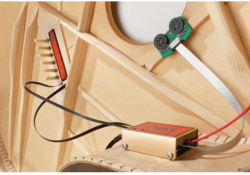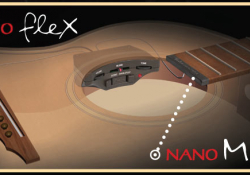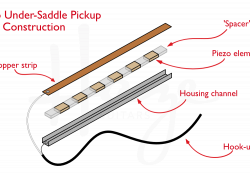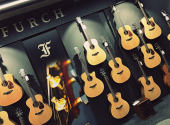
The Handbook for Electro Acoustic Guitarists, Chapter 4: Combinations
In previous episodes, we've discussed different types of pickups – but there was always a catch. In an attempt to eliminate the drawbacks, someone came up with the idea of using multiple ways of picking the sound at the same time. That shifted the paradigm and a decisive step was taken towards a high-quality amplified acoustic guitar on stage.
The magic word mentioned last time – multisource – is a combination of different types of pickups and a deliberate resignation to (futile) struggle with the disadvantages of each of these types, because there is no such thing as one truly perfect pickup (at least I haven't come across it after a quarter of a century of eager search). On the contrary, through a thoughtful collaboration of different methods and approaches, a much better result can be achieved, as in other fields where well-knit teams triumph over individuals.
I started, as most explorers do, by looking for the "perfect" piezo (UST) pickup. I tried a lot of them before I realised that from a certain point (around 40 EUR) it's not really worth thinking too much about it, because the sound differences (regardless of the material used) are very small, and besides there is still the so-called piezo quack. Here, for example, I recorded samples of different pickups (cheap Artec, classic Shadow and B-Band made of special material) in the same guitar.
I wasn't too convinced by the soundboard (SBT) pickups as the single sound source, I even sold an otherwise excellent guitar with a sophisticated SBT system because I wasn't comfortable working with the sound on stage and it didn't blend well with my other effects. I now have a new guitar with UST and SBT and it works great. This is also one of the most common combinations with the company's classic representative, the B-Band A2.2 (they only use the abbreviations UST + AST).
You can also use a combination of UST and magnetic pickup, e.g. the Shadow E-Sonic2 or Doubleplay system with a bridge nanoflex and almost invisible nanomag glued to the edge of the fingerboard, standard on Epiphone guitars.
We've also discussed the addition of a microphone before, and although I wouldn't recommend it on stage (I have four guitars equipped with Fishman Presys/Classic 4T blend pickups and I turn off the microphone because of feedback), this system can serve very well for home recording, for example. It gives a more pleasant "microphone stink" (as my colleagues and I call it internally) to the "quacking" piezo. Just don't overdo it with the microphone addition, because the sound can easily become too "boxy". The desired microphone addition can be added without the microphone itself, and it is a very convenient option for live playing, but it requires a bit more theoretical preparation, so I will deal with it later in a special episode called "Impulsive Response" (IR).
Of course, it's not entirely necessary to have eight pickups like the dazzling Rodrigo y Gabriela have in their Yamaha specials. But their story is instructive because they only started to tackle the sound system when they moved from pubs and clubs to larger stages with audiences of over a thousand and suddenly realised that their stylistic percussive ornaments weren't audible. So, after many attempts, they found that the best combination was a classic UST and seven! SBTs, appropriately positioned not only on the front but also on the back of the guitar. Because of the nylon strings, they couldn't use magnetic pickups – and part of this system is a small "computer" that mixes the individual signals into 2-3 separate outputs so that they can be amplified or run through effects separately. This leads us to the next point in the program, codenamed "Preamps", which we'll cover in the next episode. I would also like to paraphrase Gabriela's warning about dead ends – I truly love a very natural acoustic sound, but for an audience of five to ten thousand, we just can't have it. You can't use microphones, forget it.
So, how to combine the pickups? In my opinion, definitely start with a solid UST piezo and complement it with something that suits your personal taste. This is also influenced by your style of playing (fingerpicking, percussion, flatpicking, etc.), the size of the venue and accompanying musicians. With a lot of percussive techniques, I would throw in SBT, with a loud drummer, choose a magnet, for decent playing in small spaces, feel free to use MIC. There is simply no universal method, everyone has to work out their own acoustic path.
But I do have one general piece of advice for those who don't want to think too much about it. A few days after the publication of the last episode, where I praised the combined L.R. Baggs Anthem (UST+MIC), I attended a concert where the support band had a great live acoustic sound, which was agreed upon by other musicians and sound engineers. You may have guessed that it was Anthem (with an extra microphone added). Since this performance was an intimate Celtic duo, they could use a mix of three sound sources. A fellow musician told me that he had tried almost everything before, but ended up with Anthem (like most acoustic professionals he knows) – and he had installed it on three of his guitars. Only when he plays on a big stage or with a loud drummer, he uses a guitar with a smaller body instead of a dreadnought, because a bulky guitar creates feedback under those conditions anyway.
For modern acoustic virtuosos (such as Mike Dawes, Alexander Misko or Petteri Sariola), mixing multiple (or even many) pickups is a matter of course. For example, they use different mini mixing boards in the pedalboard to control the volume of each pickup independently and to run them through different effects. Pickup manufacturers are gradually responding to these trends – for example, perhaps the most respected pickup system currently available, the Cole Clark PG3, sophisticatedly combines three different pickups (UST with cut treble, SBT for woody mids, and microphone with cut bass) so that their strengths stand out while counteracting their weaknesses.
Rehearse, research, think about yourselves, your style, what you want to say and convey to your audience... and may you live up to that acoustic glory.
If you have found an error or typo in the article, please let us know by e-mail info@insounder.org.





